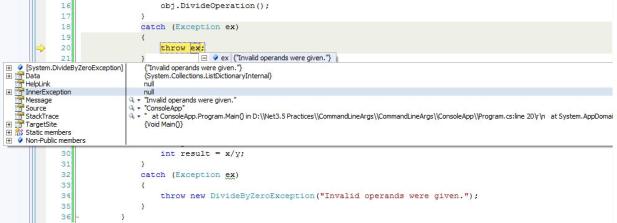Most of the time when we re-throw exception from our code block, we supply some meaningful and friendly message if any error condition occurs. This message is supplied in the constructor method of that exception type. But in this re-throwing process, we often forget to preserve Inner Exception property. And when we log the exception message (ex.Message), we lose the details of the original exception.
In the example below, we have re-thrown exception with only a friendly message in the constructor method.
private void DivideOperation()
{
try
{
int x = 5;
int y = 0;
int result = x/y;
}
catch (Exception ex)
{
throw new DivideByZeroException("Invalid operands were given.");
}
}

Fig 1: InnerException property is null.
This is, of course, not a good practice to do exception handling. So to preserve the details of the original exception, we have to pass the exception object as a second parameter in addition to friendly message as:
private void DivideOperation()
{
try
{
int x = 5;
int y = 0;
int result = x/y;
}
catch (Exception ex)
{
throw new DivideByZeroException("Invalid operands were given.", ex);
}
}

Fig 2: InnerException property detail is preserved.
One can see the difference of InnerException property value in these two cases.
CodeProject
Posted in .NET Technologies, C#/VB.NET, CodeProject, Dot NET Tips Tagged: .NET 3.5, C#, Exception Handling








